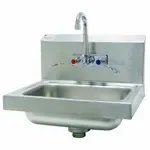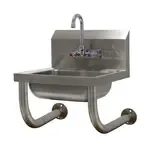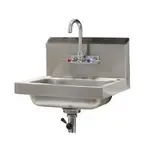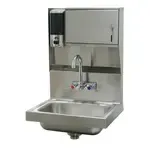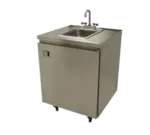
Commercial Kitchen Hand Sink Requirements: Ensuring Hygiene & Safety
In a busy commercial kitchen, adhering to codes and regulations is crucial for maintaining hygiene and safety standards. Commercial kitchen hand sinks play a vital role in effective handwashing and preventing the spread of germs. This article explores the essential requirements for these sinks, with valuable insights for foodservice professionals, restaurant owners, and kitchen managers. By understanding and meeting these codes, you can create a compliant and hygienic workspace that ensures the safety of your establishment.
The Significance of Fulfilling Sink Requirements for Commercial Kitchens
In the fast-paced world of commercial kitchens, maintaining proper hygiene and safety standards is crucial. One of the key elements in creating a healthy workspace is fulfilling the requirements for commercial kitchen hand sinks. These sinks serve as vital stations for handwashing and play a significant role in preventing the spread of germs and maintaining food safety. Whether you’re a foodservice professional, restaurant owner, kitchen manager, or simply interested in upholding hygiene in your commercial kitchen, these requirements will prove pivotal in the compliance, sanitation, and safety of your commercial establishment and employees.
Things to Consider to Meet Your Commercial Kitchen Hand Sink Requirements

When it comes to commercial kitchen hand sink requirements, there are several key factors to consider to ensure compliance and create a hygienic workspace. Commercial kitchen sinks serve as essential stations for handwashing and play a crucial role in maintaining food safety. However, proper sink maintenance and regulatory compliance are essential to ensure the upkeep of your commercial sink and kitchen alike. Let's delve into the essential elements to consider when fulfilling commercial kitchen sink requirements.
Size and Design
When selecting a commercial kitchen hand sink, size, and design are important factors to consider. The sink should be large enough to allow for thorough handwashing, accommodating the size of the users' hands comfortably. Additionally, ergonomic design features such as rounded edges and adjustable heights contribute to user comfort and ease of use. Compliance with local health department regulations regarding sink size and design is crucial to ensure you meet the required standards.
Number of Sinks
The number of sinks needed in a commercial kitchen depends on various factors such as the size of the kitchen, the volume of food preparation, and the workflow. As a general guideline, it is recommended to have at least one hand sink for every food preparation area. This ensures easy access to handwashing facilities and minimizes the risk of cross-contamination. Consider the layout and flow of your kitchen to determine the optimal number and placement of sinks.
Hot and Cold Water
The provision of both hot and cold water in commercial kitchen hand sinks is essential for effective handwashing. The temperature of the water plays a crucial role in removing bacteria and grease from the hands. Health department regulations typically require the availability of water at specific temperature ranges, usually between 100°F (38°C) and 120°F (49°C) for hot water, and below 85°F (29°C) for cold water. Proper plumbing installation and maintenance are necessary to ensure consistent water temperatures.
Faucets
Choosing the right faucets for your commercial kitchen sinks is vital for hygiene and convenience. Opt for faucets that are easy to operate, preferably hands-free or with wrist blade handles, to minimize contact and reduce the spread of germs. Additionally, consider features like adjustable water flow and aerators to conserve water and prevent splashing. Durable and easy-to-clean materials are recommended to withstand the demanding environment of a commercial kitchen.
Drainage
Effective drainage is crucial to maintain cleanliness and prevent clogs in commercial kitchen sinks. A properly designed and installed drainage system ensures efficient water flow and prevents stagnant water, which can become a breeding ground for bacteria. Regular cleaning and maintenance of drain traps and pipes is essential to prevent foul odors and blockages.
Soap Dispensers and Hand-drying
Commercial kitchen sinks should be equipped with soap dispensers and hand-drying facilities to promote proper hand hygiene. Ensure an adequate supply of liquid soap or antibacterial soap by the sinks. Hand-drying options can include paper towels or air dryers. It is important to regularly restock soap and towels, and to clean and maintain the dispensers to prevent contamination.
Signage and Lighting
Clear signage and proper lighting around commercial kitchen sinks are essential for maintaining a safe and hygienic environment. Well-placed signs can remind employees of handwashing protocols and reinforce the importance of hygiene practices. Adequate lighting ensures visibility and facilitates thorough handwashing. Regularly inspect and replace bulbs, and ensure that signage is prominently displayed and easy to read.
Backflow Prevention
Backflow prevention devices are necessary to safeguard the potable water supply in commercial kitchens. These devices prevent the reverse flow of contaminants into the water system, ensuring the cleanliness and safety of the water used in sinks. Consult with a licensed plumber to install and maintain backflow prevention devices according to local regulations and requirements.
Maintenance and Cleaning
Proper maintenance and regular cleaning of commercial kitchen sinks are essential to ensure their functionality and hygiene. Establish a cleaning schedule that includes thorough scrubbing of sinks, faucets, and drain covers. Pay close attention while cleaning to remove any accumulated grime, mineral deposits, or food particles. For stainless steel sinks, use appropriate cleaning agents and techniques to maintain their shine and prevent corrosion. Regular inspections and maintenance of plumbing connections and components are also necessary to address any issues promptly.

To Wrap Up!
In conclusion, meeting the requirements for commercial kitchen hand sinks is of utmost importance in maintaining hygiene and safety standards. By considering factors such as size and design, the number of sinks, hot and cold water provision, faucets, drainage, soap dispensers and hand drying facilities, signage and lighting, backflow prevention, and maintenance and cleaning, you can create a healthy workspace that promotes effective handwashing and minimizes the risk of contamination.
Remember, proper hand hygiene is a fundamental practice in any commercial kitchen, and adhering to commercial kitchen hand sink requirements is a crucial step in achieving that goal. By ensuring compliance with regulations and implementing best practices, you can create a safe and sanitary environment that upholds hygiene standards and protects the health of your customers and employees.
FAQ
How many sinks do you need in a commercial kitchen?
The number of sinks required in a commercial kitchen depends on factors such as the size of the kitchen and the workflow. It is generally suggested to include at least one hand sink in every food preparation area. Additional sinks may be needed based on the volume of food production and the layout of the kitchen.
What is the height of a hand sink in a restaurant?
The height of a hand sink in a restaurant typically ranges between 34 to 36 inches (86 to 91 centimeters). This height ensures ergonomic comfort for most users and complies with accessibility guidelines.
Does a commercial sink have to be stainless steel?
While not mandatory, stainless steel is the preferred material for commercial sinks due to its durability, resistance to corrosion, and ease of cleaning. Stainless steel sinks are also more hygienic as they inhibit bacterial growth. However, local health department regulations may specify the acceptable materials for commercial sinks, so it is important to consult and comply with those requirements.
What is a sink used for in a commercial kitchen?
In a commercial kitchen, sinks are primarily used for handwashing to maintain proper hygiene. They are also used for various food preparation tasks, such as washing produce, utensils, and small equipment. Some sinks may be designated for specific purposes, such as compartment sinks for dishwashing or prep sinks for food preparation.
What is the ideal size for a hand wash sink in a commercial kitchen?
The ideal size for a hand wash sink in a commercial kitchen is typically around 14 to 18 inches (36 to 46 centimeters) in width and 10 to 14 inches (25 to 36 centimeters) in depth. However, specific requirements may vary based on local health department regulations, so it is essential to check and comply with those guidelines.
